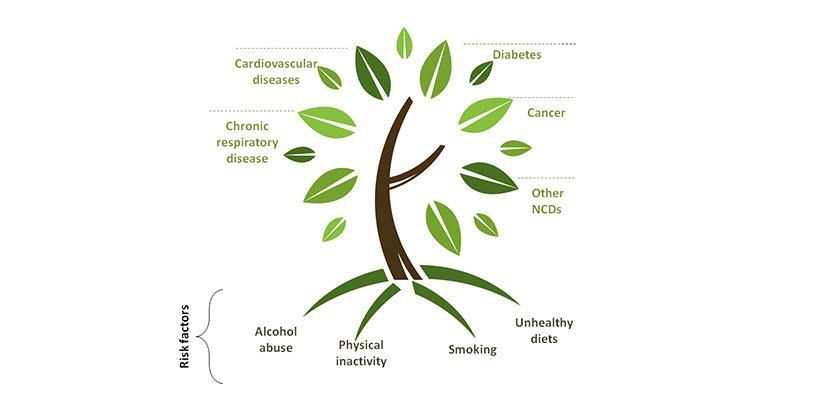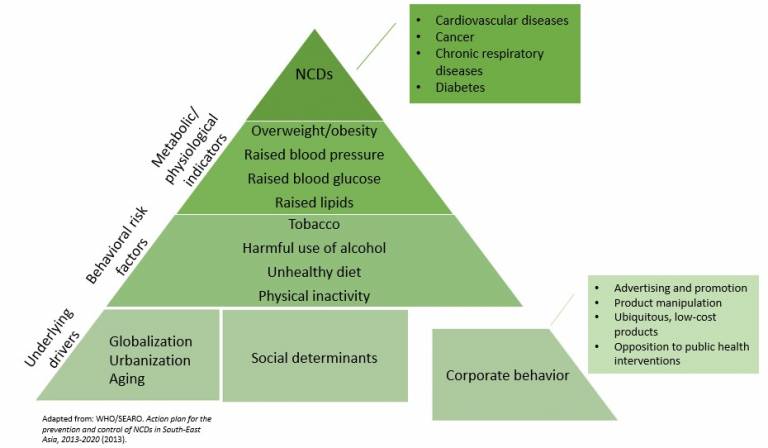Lifestyle Disease: Prevention and Risk Reduction
Nov 14, 2019
12670 Views
A Quick Look Through:
Lifestyle disorders are constituted of diseases that occur majorly on the basis of living habits and lifestyle of people. They also occur due to the relationship of the people with their respective environments. The important factors that accord to lifestyle disorders are low physical activity, food habits, disturbed sleeping patterns, competitive living, and incorrect body posture. A World Economic Forum report says India will suffer a loss of more than $200 billion due to improper diets and improper lifestyle. The report further revealed that 60% of the global deaths in 2005 happened due to noncommunicable diseases. The worst part of it is, nearly 80% of the deaths are occurring in nations like India where a majority of the people belong to low-income and middle-income groups. Also, in these countries, there’s a growing burden of nutritional deficiencies, infectious diseases, poor maternal and perinatal conditions. Improvement in living conditions, sanitation, health awareness, and timely available medical facilities will lead to a decrease in the incidence of communicable and noncommunicable diseases. On top of this, factors like economic liberalization, rapid industrialization, expansion of technology, knowledge, and information, etc., change the healthy-lifestyle in the community. However, the good news about lifestyle diseases is, they are reversible and can be prevented from causing serious damage to the overall health.

(Sources: https://sgtuniversity.ac.in/lifestyle-disorders-and-role-of-physiotherapy/)
Causes:
The most common familial causes of these lifestyle disorders are related to diet — consuming unhealthy foods, uncontrolled eating, overindulgence on artificial sweeteners, processed foods, and junk foods. In addition, addictive habits like tobacco smoking, eating paan, consumption of alcohol, irregular sleeping habits, very limited exposure to sun and fresh air, stress and modern-day urbanization have made matters worse. The most frequently observed lifestyle disorders are diabetes, obesity, hypothyroidism, cancer, hypertension, cardiovascular diseases, chronic obstructive pulmonary disease (COPD), etc.
The amount and duration of physical exercise, the type and time of work, irregular sleeping habits, poor posture, etc., are few factors which decide the onset of these lifestyle disorders. Activities like smoking and alcohol in the youth can lead to a reduction in the individual’s stamina and in the long run, is likely to cause multiple diseases.
Coming to the heart disease, it is not a single condition or a single disease. It relates to a cluster of diseases wherein the heart vessels are damaged and cannot function to the fullest. Much of the heart diseases we see are due to a sedentary lifestyle and irregular eating habits. Most commonly found heart diseases are high blood pressure and atherosclerosis. Diseases like asthma, cancers of the lung and oral cavity, and COPD are associated with smoking, alcoholism, and diet poor in vitamins and proteins.
Complications:
Lifestyle disorders can become highly complicated if unattended on time and may need a prolonged treatment procedure. Complications in case of diabetes happen over a period of time. Diabetic individuals have a high chance of developing cardiovascular diseases, various infections, and diseases damaging the kidneys, nerves, dental cavity, and eyes.
High blood sugar levels will increase the dangers of heart attack, atherosclerosis, coronary artery disease, stroke, diabetic retinopathy, glaucoma, and may often lead to kidney failure. If the wounds are not treated well, physicians may even recommend amputation. Hypertension is associated with congestive cardiac failure, myocardial infarction, hypertensive retinopathy, and uremia. Chronic Obstructive Pulmonary Diseases (COPD) is a major complication of respiratory system failure and is associated with difficulty in taking breath, confusion, and lung infections. Excess weight (obesity) increases the risk for many complications like cardiovascular diseases, type II diabetes, osteoarthritis, and stones in the gallbladder.
Alcoholism is another important lifestyle disorder that can cause alcoholic hepatitis, gastritis, cancers of the mouth, throat, liver, and colon, elevated blood pressure levels, and irregular menstruation in women and erectile dysfunction in men.
Osteoporosis is a lifestyle complication where the bones become too thin and breakable, increasing the risk for fractures. In majority of the cases, bones tend to lose their strength when there are low levels of calcium, phosphorous, and other important minerals. Osteoporosis mainly occurs in hip, wrist and spine. Fractures that occur from osteoporosis are more common in women than in men, and the risk increases with age.

(Source: https://oneill.law.georgetown.edu/corporate-behavior-an-underlying-driver-of-non-communicable-diseases/)
Relationship Between Genes and Environment:
The relationship between genes and environment is complicated, very much intricate and multi-factorial. This complex relationship determines the final outcome of overall health status. Knowing your complete genetic profile will help you delay the onset of any lifestyle disease, or can totally prevent them from happening by taking actionable steps by moving to a healthy diet and adapting to an active lifestyle. By understanding your genetic profile, you can prevent a large number of conditions such as Diabetes, Obesity, Cardiovascular Diseases by lifestyle interventions.
Management:
The modern-day sedentary lifestyle based on convenience foods and television sets and desktop computers has been linked to many lifestyle disorders including obesity in children and adults. Lifestyle experts motivate the younger generation to indulge in some form of physical exercise and encourage them to play a sport of their choice. Active involvement in sport and physical activity can help them combat depression and psychotic stress, while enabling them to overcome physiological fatigue easily. Nutritionists recommend that young individuals should be taught the importance of following a healthy and timely diet plan, with abstinence from junk and oily foods.
An interesting thing about lifestyle disorders is that they are reversible and if identified early, can be treated well. To overcome the burden of these diseases, experts encourage a positive lifestyle with a clear balanced diet, giving up on alcohol and smoking, including fruits and vegetables in your daily diet, regular physical activity and more importantly, giving due importance to your biological clock.
Usually lifestyle disorders take time to be recognized and once found would require prolonged medication. Homeopathy is one amiable choice and can be of great help to children of parents with lifestyle. This is because the medicines are less toxic and keep the body mechanisms in perfect functioning.
How Can Mapmygenome Help you:
At Mapmygenome, our focus is mainly on predictive risk assessment, maintaining a proper diet, adapting to a healthier lifestyle. A comprehensive wellness assessment like Genomepatri will give an insight into the weaknesses of your immunity, genetic predisposition to specific health conditions, drug efficiency and helps in pre-empting most of these risks. Genetic counseling is therefore recommended to obtain authenticated reviewing and recommending testing/screening options, diet/lifestyle interventions and as educational and emotional support. Tapping into your genes will assist you to know the real ‘YOU’. Genomepatri helps you find the best-suited route for yourself, and reiterates the importance of not following the crowd but forging a unique way of leading quality life. It is personalized, predictive, participatory, preventive, and POWERFUL!!!
And as the age old proverb goes, “Prevention is better than cure”.
References:
- Kendler, Kenneth S., John M. Myers, and Corey LM Keyes. “The relationship between the genetic and environmental influences on common externalizing psychopathology and mental wellbeing.” Twin Research and Human Genetics 14.6 (2011): 516-523.
- Nhp.gov.in. (2015). Lifestyle Disorder | National Health Portal of India. [online] Available at: https://www.nhp.gov.in/lifestyle-disorder_mtl [Accessed 12 Aug. 2019].
- Sharma, Mukesh, and P. K. Majumdar. “Occupational lifestyle diseases: An emerging issue.” Indian journal of occupational and environmental medicine 13.3 (2009): 109.

